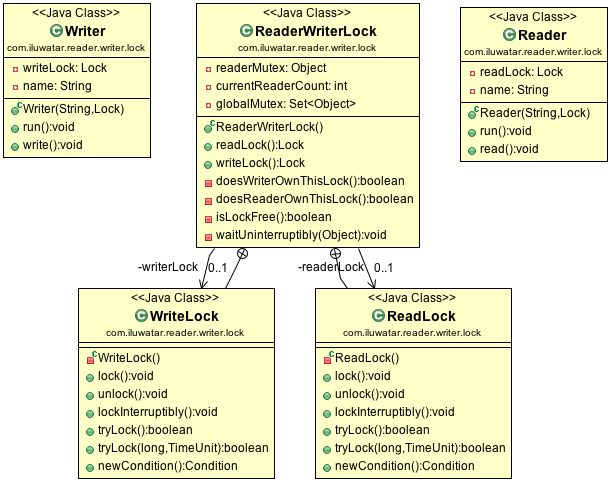Reader Writer Lock
- Concurrency
Intent
Regular lock does not distinguish the ‘read lock’ and ‘write lock’, as when access the data structure patterns consists of many threads reading the data, each thread will have to lock it which produces unnecessary serialization. The existence of reader-writer lock resolves this issue as it is well known as “multiple concurrent readers, single writer locks”, used to consist of multiple threads reading the data concurrently and allow only one thread to write or modify the data. All others (readers or writers) will be blocked while the writer is modifying or writing the data and unblocked until the writer finishes writing.
Explanation
Real world example
Consider if we obtain a database for bank accounts. If Alice wants to transfer from account1 to account2, at the same time Bob transfer money from account2 to account3. Alice will first read the totals of account1 and account2. Then, Bob's transaction executed completely. Alice is now working with outdated values, therefore, the total amount in account2 would be incorrect. With transactions, Bob would have to wait until Alice finishes her process of the accounts.
In plain words
Reader-writer lock enables either multiple readers or single writer to hold the lock at any given time.
Wikipedia says
In computer science, a readers–writer (single-writer lock, a multi-reader lock, a push lock, or an MRSW lock) is a synchronization primitive that solves one of the readers–writers problems.
Programmatic Example
In our programmatic example, we demonstrate the implementation of the access to either reader or writer. We first create a Reader class which read when it acquired the read lock. It creates the reader and simulate the read operation.
@Slf4j
public class Reader implements Runnable {
private Lock readLock;
private String name;
private long readingTime;
public Reader(String name, Lock readLock, long readingTime) {
this.name = name;
this.readLock = readLock;
this.readingTime = readingTime;
}
public Reader(String name, Lock readLock) {
this(name, readLock, 250L);
}
@Override
public void run() {
readLock.lock();
try {
read();
} catch (InterruptedException e) {
LOGGER.info("InterruptedException when reading", e);
Thread.currentThread().interrupt();
} finally {
readLock.unlock();
}
}
public void read() throws InterruptedException {
LOGGER.info("{} begin", name);
Thread.sleep(readingTime);
LOGGER.info("{} finish after reading {}ms", name, readingTime);
}
}
In the Writer class, we operate write when it acquired the writer lock. It follows the similar process as the Reader class which creates the writer and simulate the write operation.
public class Writer implements Runnable {
private final Lock writeLock;
private final String name;
private final long writingTime;
public Writer(String name, Lock writeLock) {
this(name, writeLock, 250L);
}
public Writer(String name, Lock writeLock, long writingTime) {
this.name = name;
this.writeLock = writeLock;
this.writingTime = writingTime;
}
@Override
public void run() {
writeLock.lock();
try {
write();
} catch (InterruptedException e) {
LOGGER.info("InterruptedException when writing", e);
Thread.currentThread().interrupt();
} finally {
writeLock.unlock();
}
}
public void write() throws InterruptedException {
LOGGER.info("{} begin", name);
Thread.sleep(writingTime);
LOGGER.info("{} finished after writing {}ms", name, writingTime);
}
}
Now, in the ReadWriteLock class which would take the responsibilities to control the access for either the reader or the writer. In the ReadLock class, it restricts that if there's no writer that gets the lock, then multiple readers could be access concurrently. In the WriteLock class, it restricts that only one writer could be accessed.
public class ReadWriteLock implements ReaderWriterLock {
private final Object readerMutex = new Object();
private int currentReaderCount;
private final Set<Object> globalMutex = new HashSet<>();
private final ReadLock readerLock = new ReadLock();
private final WriteLock writerLock = new WriteLock();
public Lock readLock() {
return readerLock;
}
public Lock writeLock() {
return writerLock;
}
private boolean doesWriterOwnThisLock() {
return globalMutex.contains(writerLock);
}
private boolean isLockFree() {
return globalMutex.isEmpty();
}
private class ReadLock implements Lock {
@Override
public void lock() {
synchronized (readerMutex) {
currentReaderCount++;
if (currentReaderCount == 1) {
acquireForReaders();
}
}
}
@Override
public void unlock() {
synchronized (readerMutex) {
currentReaderCount--;
if (currentReaderCount == 0) {
synchronized (globalMutex) {
globalMutex.remove(this);
globalMutex.notifyAll();
}
}
}
}
}
private class WriteLock implements Lock {
@Override
public void lock() {
synchronized (globalMutex) {
while (!isLockFree()) {
try {
globalMutex.wait();
} catch (InterruptedException e) {
LOGGER.info("InterruptedException while waiting for globalMutex to begin writing", e);
Thread.currentThread().interrupt();
}
}
globalMutex.add(this);
}
}
@Override
public void unlock() {
synchronized (globalMutex) {
globalMutex.remove(this);
globalMutex.notifyAll();
}
}
}
}
Class diagram

Applicability
Use the Reader-writer lock when:
- You need to increase the performance of resource synchronize for multiple thread, in particularly there are mixed read/write operations.
- In the bank transaction system, you want to ensure when two users are transacting the same account, one people will wait until the other finishes.